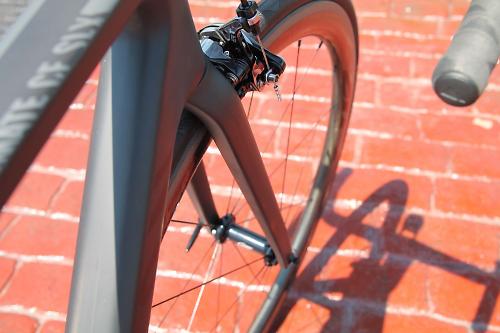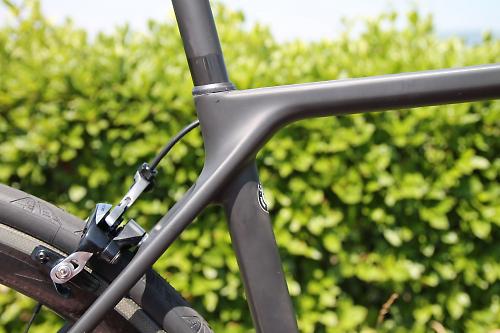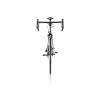- News
- Reviews
- Bikes
- Components
- Bar tape & grips
- Bottom brackets
- Brake & gear cables
- Brake & STI levers
- Brake pads & spares
- Brakes
- Cassettes & freewheels
- Chains
- Chainsets & chainrings
- Derailleurs - front
- Derailleurs - rear
- Forks
- Gear levers & shifters
- Groupsets
- Handlebars & extensions
- Headsets
- Hubs
- Inner tubes
- Pedals
- Quick releases & skewers
- Saddles
- Seatposts
- Stems
- Wheels
- Tyres
- Tubeless valves
- Accessories
- Accessories - misc
- Computer mounts
- Bags
- Bar ends
- Bike bags & cases
- Bottle cages
- Bottles
- Cameras
- Car racks
- Child seats
- Computers
- Glasses
- GPS units
- Helmets
- Lights - front
- Lights - rear
- Lights - sets
- Locks
- Mirrors
- Mudguards
- Racks
- Pumps & CO2 inflators
- Puncture kits
- Reflectives
- Smart watches
- Stands and racks
- Trailers
- Clothing
- Health, fitness and nutrition
- Tools and workshop
- Miscellaneous
- Buyers Guides
- Features
- Forum
- Recommends
- Podcast
TECH NEWS
Canyon unveils new Ultimate CF SLX with aero features
Canyon has unveiled a brand new Ultimate CF SLX for 2016 at the Movistar base in Pamplona, Spain. The German company claims it's 10 per cent more comfortable with 10 per cent less drag than the previous model, which was ridden to success in the 2014 Giro d’Italia.

As well as being 10 per cent more compliant and 10 per cent more aerodynamic, the new Ultimate maintains the same stiffness to weight ratio as the previous version. Canyon claims a 780g frame weight and a 295g fork, with a frameset weight of 1,130g.
The new frame has a new D-shape down tube, integrated seatpost clamp, slender D-shaped seatstays, aero optimised bottle cage positions, narrow fork blades, a flat and broad top tube and a narrow and non-tapered 1 1/4in head tube.

Canyon proudly calls the new bike “engineered perfection”. Stiffness to weight ratio, aerodynamics, industrial design, and comfort have been the four pillars of frame design during a two-year design and development process. It claims a 7.4 watt saving for the frameset and 12.9 watt with the frame and cockpit compared with the previous Ultimate.

The new Ultimate for the first time has been enhanced with aerodynamic design. It hasn’t just taken the Trident 2.0 tube profiles developed for the Aeroad, though, as it reckons this tube shape is only really effective above a certain aspect ratio, and not suitable for the Ultimate’s goal.
“Adopting previously developed tube profiles such as Trident 2.0, as used on the Aeroad CF SLX, was not an option as these are only effective when they are applied above a certain aspect ratio, something that was incompatible with the voluminous tube shapes required to achieve our STW targets,” says Canyon.
 copy.jpg)
So it developed a brand new tube shape. The D-shape down tube has a narrower and rounder nose profile compared with the previous Ultimate, designed to decrease flow separation by ensuring the air sticks to the tube. The new down tube is narrower which impacts stiffness, so to counter this, Canyon developed a new box section top tube and wider seat stays to provide the necessary frame stiffness. It claims the stiffness to weight ratio is identical to the previous UItimate.
 copy.jpg)
A focus for the new frame has been to reduce the frontal surface area, so it has concentrated on the head tube and fork blades to minimise their cross-section. That’s why it has opted to use a non-tapered 1 1/4in steerer tube, to minimise the width of the head tube and keep it as narrow as possible, helped further by the hourglass profile. That’s combined with a compact Acros headset bearing, as seen first on the Aeroad.

As well as aerodynamics, comfort has also been considered with the new Ultimate. The new bike is claimed to have 15 per cent more vertical deflection and 37 per cent horizontal deflection, with 13 per cent less saddle tilt, when tested with a regular seatpost. This increase in ride comfort is due to a new integrated seatpost clamp, which has been moved from the typical location at the top tube to further down the seat tube, close to the seatstays. This approach, claims Canyon, frees up the seatpost to provide more vertical displacement.

“The fundamental difference here is that the actual clamp is moved from the conventional position at the exit of the seat tube further down inside the frame,” says Canyon. “The hybrid injection moulded synthetic insert is one of the most complex components Canyon has ever developed and consists of three parts: a fibre-reinforced base, a soft seal where the seat tube ends and an aluminium press to transfer the tightening screw’s force onto the seatpost.”
The seat tube has been optimised too, and the seatstays have a new D-shaped profile as well, and frames will be available with Canyon’s novel VCLS seatpost.As well as improved aerodynamics and comfort, Canyon has used this update to sweat the details. All cables are internally routed and Canyon has improved the cable routing, minimising the angles that the cables enter and exit the frame to provide as smooth a run as possible. There’s a new dropout hanger for the rear mech that offers a claimed 25 per cent increased stiffness.
We'll have lots more on this new bike soon...
David worked on the road.cc tech team from 2012-2020. Previously he was editor of Bikemagic.com and before that staff writer at RCUK. He's a seasoned cyclist of all disciplines, from road to mountain biking, touring to cyclo-cross, he only wishes he had time to ride them all. He's mildly competitive, though he'll never admit it, and is a frequent road racer but is too lazy to do really well. He currently resides in the Cotswolds, and you can now find him over on his own YouTube channel David Arthur - Just Ride Bikes.
Latest Comments
- David9694 1 hour 36 min ago
Active travel schemes are 'squeezing out motorists in favour of cyclists' Go Rochdale!
- mdavidford 2 hours 11 min ago
You don't like the Look of it then?
- chrisonabike 2 hours 22 min ago
TBF I think their complaint was with the design as proposed. There would be a cycle path with cyclists moving in two directions with little buffer...
- dh700 5 hours 43 min ago
I'd argue that nothing at all is wrong with the bans that you describe -- and they exist in some places....
- slc 6 hours 5 min ago
You seem to be forgetting the first article in our great constitution. A citizen has the right to store motor vehicles immediately outside their...
- Jakrayan 7 hours 12 min ago
Yeah, the number of times I've had oncoming drivers overtake a stationary vehicle - parked car on their side for example - forcing me to hit the...
- bobbinogs 7 hours 29 min ago
I always think that the Pearson font is such a dreadful choice, it's almost impossible to read.
- David9694 11 hours 23 min ago
A bit of light rain is all it was on Friday ...


















Add new comment
46 comments
Geo seems to have changed from the 'old' one - more reach and/or lower stack height depending on how you look at it. Size S (which I like to think of as my size) now has reach of 385 vs 375 before. Going down to XS to get closer to the old reach (now 378) drops the stack from 546 to 522.
Which is a shame I think as they used to be handily in the middle of the Supersix Evo long and low / Cervelo short and upright size range.
How much of the aero gains I wonder are a result of it becoming effectively a smaller bike?
Thinking to replace my Tarmac Sport with this!
MamilMan wrote:
Every one talking about discs... I have a road bike with discs and am not that impressed
I have mtb and road bike with hydraulic disc brakes. The brakes are phenomenal in all conditions. Braking modulation is very easy without wheel grab. Also I have just bought a second set of wheels for my road bike, without any adjustments they fitted first time and didn't catch the pads and spin smoothly. The peleton won't have problems with wheel swaps.
Am I the ONLY person in the world to notice that Canyon have switched from 'direct' mount calipers to standard central bolt mount calipers?
Every one talking about discs... I have a road bike with discs and am not that impressed.
Direct mount brakes are more powerful as the fulcrum point is closer to the pad and was looking at this as an option and now they've changed it...
So in the 'calipers Vs discs' battle could anyone throw into the ring the difference ditching direct mount calipers is going to have on this frame?
The 'old' CF SLX had central mount didn't it ?
There are plenty of shit discs in exactly the same way as there are plenty of shit rim brakes.
Power alone doesn't make for a good brake set - a crowbar through the spokes is plenty powerful enough.
I've had the misfortune to have ridden a 'full suspension' bike that came out of sports direct ... It was utter shite, but I didn't therefore conclude that full suspension as a concept was shite.
What make model discs have you got? It's only fairly recently that cable discs have really become decent, and the hydraulic ones are in a different league altogether.
Also, are your pads/disc contaminated. One (in my view, the only) downside of discs is that it's much easier to knacker you pads accidentally (e.g not shielding them fully when using a spray lube) and once they are contaminated it can be impossible to resurrect them.
Erm, what? Direct mount rim brake callipers have no individual part to play in the rim vs disc debate, because they are still rim brakes and thus are trumped comprehensively by any decent disc brake.
And ditching them on this frame, if that's what they've done will make difference cause the newer single bolt shimano brakes are designed to function like direct mount brakes (I.e. very similar pivot point for each arm).
That integrated Garmin mount is very cool.
Love it! That's the best way I've heard of saying "This one isn't as stiff as the old one".
WHAT HAS HAPPENED TO LATERALLY STIFF YET VERTICALLY COMPLIENT?
p.s. TAKE MY MONEY NOW!
Carbon snaps in crashes.
Everything breaks when you hit it hard enough.
Aluminium dents/bends beyond repair. So does lightweight steel and titanium. If it doesn't, it's not lightweight most likely.
So do bones, so why bother cycling at all.
So do bones, so why bother cycling at all.
"Engineered perfection" they say, so that means they won't be releasing a new version in a couple of years and claiming that one is x% stiffer / more aero / more comfortable?!?
It's a nice looking bike, I'm sure it rides nicely too, but I'm just sick of this endless marketing hyperbole.
The integrated Garmin mount looks good though.
Non-tapered headset and wider seat stays..... And apparently they improve things....so what does that say about all the other brands claiming an improved bike with thinner stays and tapered steerer tube?
Lovely bike by the way
The seat stays are only wider (wider, not necessarily thicker vertically) to make up for lesser stiffness they introduced elsewhere - or so they say. Steerer tubes ? Meh. Like the idea of proper tapered ones from an engineering point of view but not convinced on the noticeable benefit for 99.9999% of users.
Yeah, bit like a Yorkie - chunky but tasty.
You might be mixing things here slightly. Thinner could mean thinner tube walls or smaller diameter, or indeed thinner across one plane but not the other (i.e. flattened), and wider could mean larger diameters, or precisely the same thing about flattening the tubes. Looks to me like Canyon have flattened the tubes to make them more leaf spring like - old technology but in a new form!
As for the steerer tube, depends on the bike and what the manufacturer is looking for. If they value steering stiffness over everything else, you'll see a 1.5 lower, but if aero is the crucial thing, then 1 1/4 seems common at the expense of a little steering precision.
Those frames look bloody awful, too chunky.
I think they look really nice. I didn't used to like the Aeroad. But then they redid that, and now I think it also looks really nice.
If a bank gets robbed in Belgium, u now know why!
I said to my wife, that I don't need new bike last week. I should tell her new story now.
it maintains the same stiffness to wight ratio as the old bike if it is lighter does this mean it is more floppy.
Never mind that, Canyon, where's the Endurace Disc, eh?
That looks slippery as a weasel in baby oil.
I want one! Maybe with a splash of color though.
Weasel ?
Is the disc or no disc debate, the new 2015 helmet or no helmet debate?
Yep! Only difference is us disc advocates know full well that in a few years everyone will be riding discs cause the Luddites will come to realise that they are simply better in every way!
Yep-spend 2 years developing the lowest aero drag possible......and then throw on 2 anchors and a couple of sails (aka discs and calipers).
Hmm - ok, i'll bite.. even assuming you're right and that the results so far about the aero effects of discs and calipers (i.e. not as bad as you might think) are wrong, would you prefer to have them on top of a bike with not-so-great aerodynamics or one with rather better aerodynamics ?
1. All tests so far have shown that discs have a very small effect, that is completely outweighed by the time gained through ability to brake later.
2. Discs will allow freedom in rim development which I think will result in more aero dynamic wheels.
Combine the two and a disc brake bike could I fact be 'more' aero than a caliper brake bike!
Pages